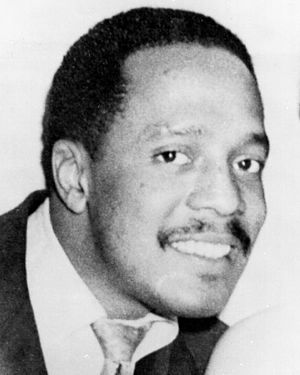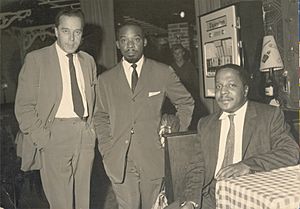Bud Powell facts for kids
Quick facts for kids
Bud Powell
|
|
|---|---|

Powell, c. 1953
|
|
| Background information | |
| Birth name | Earl Rudolph Powell |
| Born | September 27, 1924 Harlem, New York, U.S. |
| Died | July 31, 1966 (aged 41) New York City, New York, U.S. |
| Genres | Jazz, bebop |
| Occupation(s) | Musician |
| Instruments | Piano |
| Years active | 1944–1965 |
| Labels | Roost, Blue Note, Mercury, Norgran, Clef, Verve |
| Associated acts | Charlie Parker, Dizzy Gillespie, Art Blakey, Miles Davis, Dexter Gordon, Charles Mingus, Sonny Rollins |
Earl Rudolph "Bud" Powell (born September 27, 1924 – died July 31, 1966) was an American jazz pianist and composer. He was a very important person in the development of modern jazz. He helped create this new style of music. Many people called him the "Charlie Parker of the piano" because he was so skilled. He also wrote many jazz songs. His playing and compositions helped make jazz harmony much richer and more interesting.
Contents
Life and Music Journey
Early Life and Musical Start
Bud Powell was born in Harlem, New York, United States. His father was a piano player who played a style called stride piano. Bud started taking classical piano lessons when he was just five years old. His first teacher was a man named Rawlins.
When Bud was 10, he became very interested in swing music. He heard it everywhere in his neighborhood. He first played in public at a party, where he copied the style of famous pianist Fats Waller. The first jazz song he learned really well was "Carolina Shout" by James P. Johnson. Bud's older brother, William, played the trumpet and violin. By the time Bud was 15, he was playing piano in William's band. Bud also listened to Art Tatum on the radio and tried to play as well as him. Bud's younger brother, Richie Powell, also became a well-known bebop pianist.
Becoming a Jazz Star in the 1940s
When he was young, Bud Powell often listened to music at a place called Uptown House. This was where Charlie Parker first played by himself in New York. Thelonious Monk also played there. When Monk met Bud, he introduced him to other musicians who were starting to play bebop at Minton's Playhouse. Monk was the main pianist there, and he saw Bud as his talented student. They became good friends, and Monk was a huge help to Bud. Bud loved trying out Monk's new musical ideas. Monk even wrote a song called "In Walked Bud" to honor their friendship in Harlem.
Bud played in several dance bands. Eventually, he became the pianist for the swing orchestra led by Cootie Williams. In late 1943, he had a chance to play at a nightclub with a group that included Oscar Pettiford and Dizzy Gillespie. However, Bud's mother wanted him to stay with the more steady job he had with Cootie Williams's popular band.
Bud played piano on some of Cootie Williams's recordings in 1944. One of these recordings was the very first time Monk's song "'Round Midnight" was recorded.
From 1945 to 1946, Bud recorded with many other famous jazz musicians like Sarah Vaughan, Dexter Gordon, and Charlie Parker. Bud became known for how well he could read music and how fast he could play. Charlie Parker chose Bud to be his pianist for a recording session in May 1947. This was the only time Parker and Powell recorded together in a studio.
Amazing Solo and Trio Recordings
After a short time in the hospital in 1949, Bud Powell made many recordings over the next two and a half years. Most of these were for record labels like Blue Note and Mercury. He also recorded with Max Roach and Curly Russell. These recordings showed that Bud was just as talented as any other bebop musician.
His first Blue Note recording session in August 1949 included famous musicians like Fats Navarro and Sonny Rollins. They recorded songs like "Bouncing with Bud" and "Dance of the Infidels." Another important Blue Note session in 1951 featured Bud with Curley Russell and Max Roach. They recorded "Parisian Thoroughfare" and "Un Poco Loco." "Un Poco Loco" was even chosen by a famous literary critic as one of the greatest American artworks of the 20th century!
Bud continued to record for Blue Note throughout the 1950s. In 1953, he recorded his song "Glass Enclosure" with a trio. On May 15, 1953, he played a famous concert at Massey Hall in Toronto. He played with a group that included Charlie Parker, Dizzy Gillespie, Charles Mingus, and Max Roach. This amazing performance was recorded and released as the album Jazz at Massey Hall.
Time in Paris and Later Years
In 1959, Bud Powell moved to Paris, France, with Altevia Edwards and her son. He continued to perform and record music there.
In 1963, Bud became sick with tuberculosis. The next year, he returned to New York to play at a club called Birdland. His health made it harder for him to perform as well as he used to. He passed away on July 31, 1966, from tuberculosis.
Bud Powell's Music Style
Bud Powell was greatly influenced by two other jazz pianists: Thelonious Monk and Art Tatum.
When he played solos, he had a very strong and direct style, almost like a horn player. He often used arpeggios (playing notes of a chord one after another) and many chromatic notes (notes outside the main scale).
When he played chords to support other musicians (called comping), he often played single bass notes. He would play the root (the main note of the chord) and the fifth (the fifth note in the scale from the root). He also used chords that included the root and the tenth (an octave and a third above the root) or the root with the minor seventh.
Discography
Images for kids
See also
 In Spanish: Bud Powell para niños
In Spanish: Bud Powell para niños




